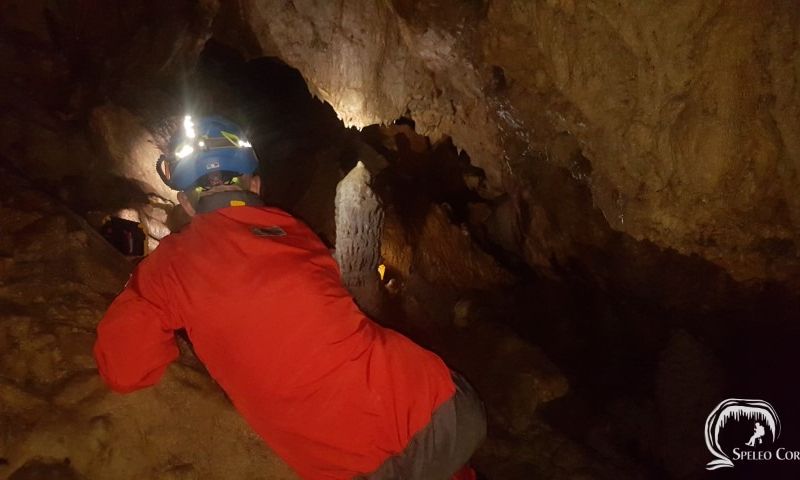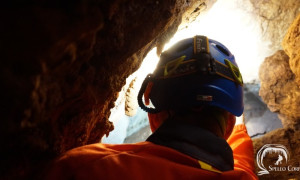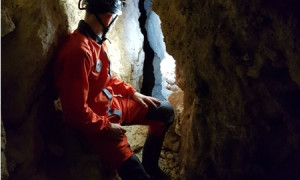Exploration of Anthropograva cave in Klimatia by speleologist and caver René van Vliet

caves
12 Sep 2019
/ 09:14
CORFU. The Dutch speleologist and caver is continuing his exploration of Corfu caves - bringing to light places that have been seen by very few people.
Recently, René van Vliet visited the Anthropograva cave in Klimatia, He told us, "The Anthropograva cave is located in Klimatia at an altitude of 270 metres just off the road leading to the Agia Triada monastery. The cave entrance is 4m wide and 2.5m high.
The first section of the cave is a downhill passage 7m long, 11m wide and 3m high. At the bottom of the passage there is an opening to a chamber 27m long and 20m wide with a height that varies from 2 to 0.5m. There are two large boulders in here which reach the top of the chamber.
The entire cave has a left to right gradient which several boulders have rolled down and is divided into a left and right section.

The speleologist in the left-hand section of the cave.

Photo taken by the speleologist.
The left-hand section of the cave has a large number of recesses with small columns, stalactites and stalagmites and a low ceiling - in the first 20m the height goes from 1.5m to 0.8m. It continues for another 18m and it is extremely difficult to crawl between the boulders, stalagmites and columns as the height is only about 0.5m. These obstacles make it difficult to determine the exact length of the left-hand section.

Right-hand section of the cave.
The right-hand section of the cave is the main chamber - measured from the cent25m long and 21m wide. The height reaches 6.5m and on the far right there is a group of stalagmites. The largest of these is 2.5m high and resembles the Tower of Pisa.The walls are the most richly decorated part of the cave.
At this there are two sinks 4.5m deep which lead to a second, lower level in the cave. The left-hand side of the second level is connected to the right-hand side of the first level and is, in fact, a descending chamber with a very low ceiling separated by rows of fallen rock dividing the cave into two levels.

The speleologist explored the whole cave.
Speleologists have a great interest in the cave because the present entrance is not the main one - it was created by a roof fall. The rock separating it from the surface was not thick and so the wall collapsed and an entrance opened. The main entrance must have been located in the centre of the left-hand section judging by the depressions in the ground above and to the left of the present cave entrance."
The speleologist and caver René van Vliet is doing research in Corfu from 27 August to 13 September. More information about the caves in Corfu can be found on the Speleo Corfu website.

René van Vliet would like to thank all those who assisted him. "I was able to visit the cave thanks to the kind and significant help of Corfu Tourist, CanyonZone (Netherlands), Rodcle (Spain), AventureVerticale (France), Climbing Technology (Italy), Vasilikos / Nitecore (Thessaloniki)".
The first section of the cave is a downhill passage 7m long, 11m wide and 3m high. At the bottom of the passage there is an opening to a chamber 27m long and 20m wide with a height that varies from 2 to 0.5m. There are two large boulders in here which reach the top of the chamber.
The entire cave has a left to right gradient which several boulders have rolled down and is divided into a left and right section.

The speleologist in the left-hand section of the cave.

Photo taken by the speleologist.
The left-hand section of the cave has a large number of recesses with small columns, stalactites and stalagmites and a low ceiling - in the first 20m the height goes from 1.5m to 0.8m. It continues for another 18m and it is extremely difficult to crawl between the boulders, stalagmites and columns as the height is only about 0.5m. These obstacles make it difficult to determine the exact length of the left-hand section.

Right-hand section of the cave.
The right-hand section of the cave is the main chamber - measured from the cent25m long and 21m wide. The height reaches 6.5m and on the far right there is a group of stalagmites. The largest of these is 2.5m high and resembles the Tower of Pisa.The walls are the most richly decorated part of the cave.
At this there are two sinks 4.5m deep which lead to a second, lower level in the cave. The left-hand side of the second level is connected to the right-hand side of the first level and is, in fact, a descending chamber with a very low ceiling separated by rows of fallen rock dividing the cave into two levels.

The speleologist explored the whole cave.
Speleologists have a great interest in the cave because the present entrance is not the main one - it was created by a roof fall. The rock separating it from the surface was not thick and so the wall collapsed and an entrance opened. The main entrance must have been located in the centre of the left-hand section judging by the depressions in the ground above and to the left of the present cave entrance."
The speleologist and caver René van Vliet is doing research in Corfu from 27 August to 13 September. More information about the caves in Corfu can be found on the Speleo Corfu website.

René van Vliet would like to thank all those who assisted him. "I was able to visit the cave thanks to the kind and significant help of Corfu Tourist, CanyonZone (Netherlands), Rodcle (Spain), AventureVerticale (France), Climbing Technology (Italy), Vasilikos / Nitecore (Thessaloniki)".







1557236612.jpg?crop=300,180)